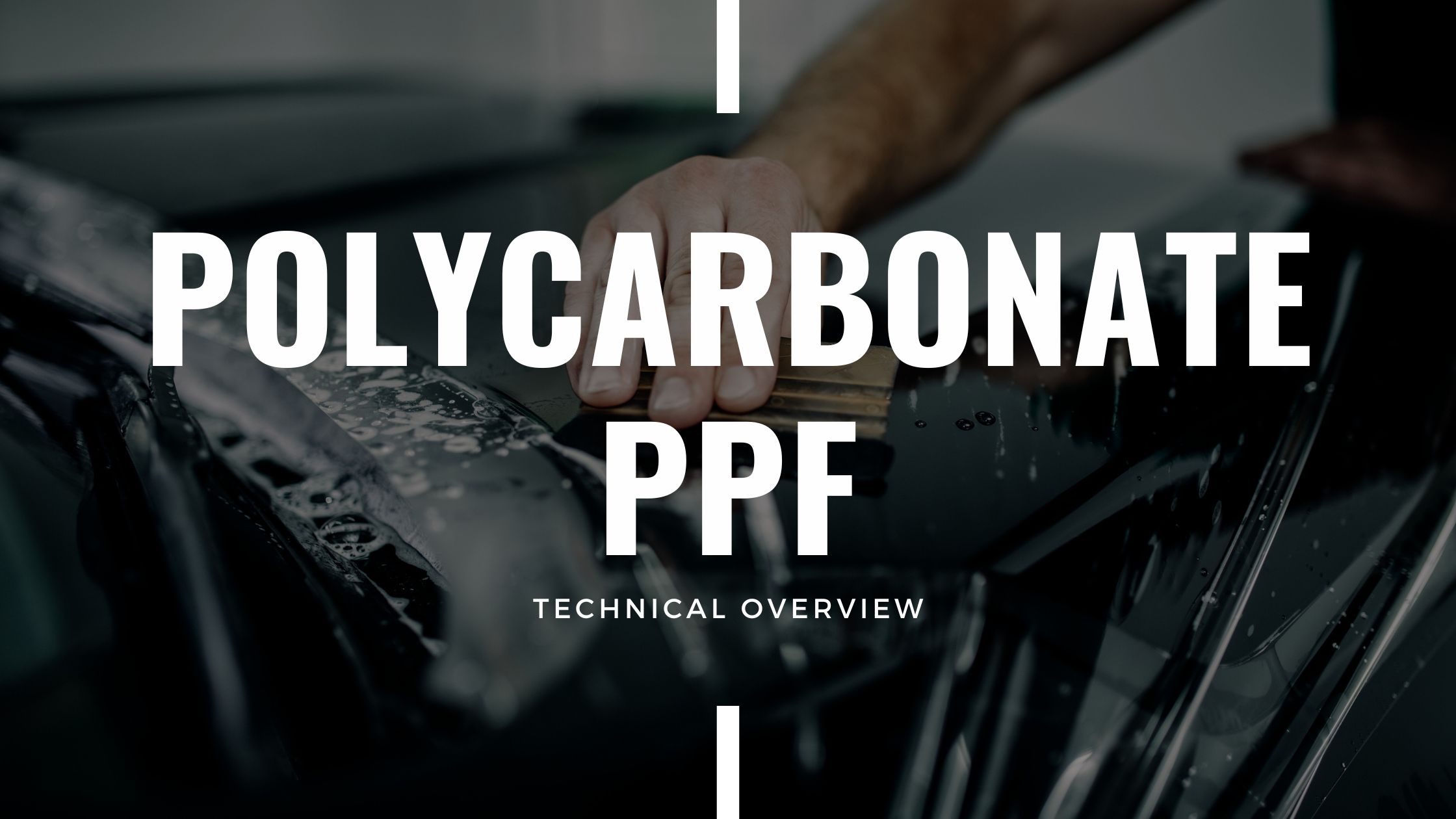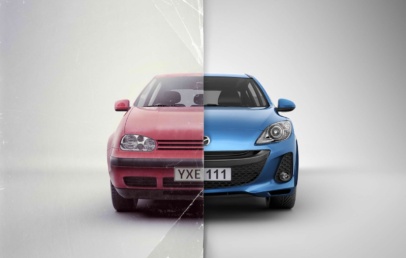A Comprehensive Technical Overview of Polycarbonate Paint Protection Film (PPF)
In the realm of vehicle protection technologies, Paint Protection Film (PPF) has emerged as a leading solution for safeguarding automotive surfaces from environmental, mechanical, and chemical damage. While there are several types of PPF available—most notably TPU (Thermoplastic Urethane)—one of the more specialized and robust options is Polycarbonate (PC) PPF. Known for its superior impact resistance and durability, polycarbonate PPF is an advanced, high-performance solution suited for extreme protection requirements in both automotive and industrial applications. This blog delves deep into the chemistry, properties, applications, and performance comparisons of polycarbonate PPF, offering a technical guide for professionals and enthusiasts alike.
1. Chemical Composition of Polycarbonate PPF
Polycarbonate is a high-performance thermoplastic polymer made through the polymerization of bisphenol A (BPA) and phosgene (COCl₂). This reaction produces long molecular chains that contain carbonate groups (-O-(C=O)-O-), which contribute to the material’s outstanding mechanical and thermal properties. Polycarbonate exhibits a unique combination of high transparency, impact resistance, and thermal stability, making it ideal for protective films that demand superior performance.
1.1 Polycarbonate Resin
At the core of polycarbonate PPF is the polycarbonate resin, which imparts structural rigidity and toughness. This base material is crucial for creating a film that can withstand high-impact forces, maintain optical clarity, and resist environmental degradation.
1.2 Additives and Coatings
To enhance the performance of the polycarbonate PPF, several additives are incorporated during the manufacturing process. These include:
- UV Stabilizers: Polycarbonate naturally degrades under prolonged UV exposure, leading to yellowing and reduced strength. UV stabilizers are added to counteract this, extending the service life of the film.
- Anti-Yellowing Agents: These additives prevent discoloration caused by environmental factors, ensuring long-term optical clarity.
- Surface Coatings: Scratch-resistant coatings, hydrophobic (water-repellent) layers, and oleophobic (oil-repellent) coatings are often applied to enhance surface hardness, reduce contamination, and improve ease of cleaning.
2. Mechanical and Optical Properties of Polycarbonate PPF
Polycarbonate PPF is a high-performance material designed to provide superior protection across various performance parameters. The following sections outline the key technical characteristics that define polycarbonate PPF and make it one of the most robust protection solutions available.
2.1 Impact Resistance
One of the hallmark features of polycarbonate is its extraordinary impact resistance. Compared to glass, polycarbonate is approximately 250 times more impact-resistant, and compared to standard TPU PPF, it offers at least 10 times the impact protection. This makes it an ideal choice for applications where the vehicle is exposed to frequent impacts from road debris, stones, and other hazardous elements.
Impact Resistance Values:
- Tensile Strength: 60-80 kJ/m² (ISO 179)
- Rock Chip Resistance: Polycarbonate PPF excels in high-impact zones such as the front bumper, hood, and wheel arches, where rock chips and debris frequently cause damage. It can withstand the energy from high-velocity impacts without suffering punctures or deformation.
2.2 Optical Clarity
Polycarbonate has exceptional optical properties, with light transmission levels of up to 90% or higher. The material’s optical clarity ensures that it does not interfere with the vehicle’s appearance, maintaining the paint’s original color and shine.
Key Optical Parameters:
- Transparency: ≥ 90% light transmission (depending on thickness)
- Haze: Less than 1% (ASTM D1003), ensuring a crystal-clear view of the underlying paint.
Despite its toughness, polycarbonate’s transparency ensures that the protective layer remains visually unobtrusive, preserving the aesthetic value of the car.
2.3 UV Resistance
Polycarbonate, while naturally susceptible to UV radiation, is treated with UV stabilizers in PPF applications to resist the harmful effects of sun exposure. These stabilizers inhibit molecular degradation caused by UV rays, preventing yellowing, cracking, or loss of transparency.
UV Resistance Features:
- Service Life: With appropriate UV stabilizers, polycarbonate PPF has a service life ranging from 5 to 10 years, depending on environmental exposure.
- Anti-Yellowing Protection: Essential for ensuring long-term optical performance in regions with high sun exposure.
2.4 Scratch and Abrasion Resistance
Unlike TPU PPF, which is often self-healing, polycarbonate is naturally more susceptible to scratches due to its rigid structure. However, most polycarbonate PPF solutions are treated with scratch-resistant coatings to improve surface hardness. These coatings dramatically reduce the risk of damage from washing, wiping, and exposure to abrasive materials.
Surface Hardness Rating:
- Hardness: Typically ranges from 2H to 4H (ASTM D3363), with additional coatings available to increase the hardness and abrasion resistance.
2.5 Flexibility and Elongation
While polycarbonate PPF provides outstanding protection, its flexibility is somewhat lower than that of TPU. It is less conformable around sharp curves and intricate body panels, but modern manufacturing techniques can improve its pliability through lamination of thinner layers or the incorporation of flexible additives.
Flexibility Data:
- Elongation at Break: 80-100% (ISO 527-2), which, while sufficient for many applications, is less than the 300-500% elongation typical of TPU films.
- Thickness: Commonly available in thicknesses ranging from 150-300 microns, where the higher thickness offers better protection but less flexibility.
2.6 Temperature Resistance
Polycarbonate has excellent thermal properties, making it suitable for high-temperature applications where standard films may deform or degrade. The thermal stability of polycarbonate allows it to withstand the heat generated from vehicle engines or harsh environmental conditions.
Thermal Properties:
- Melting Point: 155°C (311°F)
- Operating Temperature Range: Continuous use up to 120°C (248°F), which makes it suitable for areas like hoods and near exhaust systems.
2.7 Chemical Resistance
Polycarbonate is generally resistant to a wide range of chemicals, making it effective against automotive fluids, including oils, solvents, and fuels. However, without proper surface treatments, polycarbonate can be vulnerable to highly aggressive chemicals like acetone or benzene.
Chemical Compatibility:
- Resistant To: Oils, road salts, water, mild cleaning agents.
- Vulnerabilities: Strong solvents (e.g., acetone, benzene) can damage polycarbonate without protective coatings.
3. Polycarbonate PPF: Manufacturing Process
The manufacturing process of polycarbonate PPF is complex and involves several stages to ensure the film delivers maximum protection and performance:
3.1 Extrusion
Polycarbonate resin is melted and extruded into thin sheets with controlled thickness (typically 150-300 microns). The extrusion process is precisely controlled to achieve consistent thickness and ensure uniform material properties.
3.2 Coating and Surface Treatments
After extrusion, the polycarbonate film undergoes various surface treatments:
- Scratch-Resistant Coating: This layer increases the film’s hardness and protects against abrasion.
- UV and Anti-Yellowing Treatments: To combat UV degradation, the film is coated with UV inhibitors.
- Hydrophobic and Oleophobic Layers: Optional coatings can repel water, oil, and dirt, making the film easier to clean and less prone to contamination.
3.3 Lamination
In some variants, the film may be laminated with additional layers to improve flexibility and enhance impact resistance. The lamination process can combine different materials or multiple polycarbonate layers to tailor the film’s performance characteristics.
4. Polycarbonate PPF: Applications
Polycarbonate PPF is designed for high-performance applications where standard TPU PPF may not provide sufficient protection. Its superior strength and impact resistance make it ideal for:
- Commercial Vehicles: Heavily used trucks, buses, and construction vehicles that face extreme road conditions.
- High-Performance Sports Cars: Racing and sports cars benefit from polycarbonate PPF in high-impact zones such as the front bumper, hood, and side mirrors.
- Motorcycles and ATVs: Particularly useful for off-road vehicles where exposure to rocks and rough terrain is common.
- High-Wear Areas: Applied in areas prone to frequent contact or high abrasion, such as rocker panels, door edges, and around wheel wells.
5. Advantages and Limitations of Polycarbonate PPF
Advantages:
- Unmatched Impact Resistance: Superior to TPU, polycarbonate provides exceptional protection against high-velocity debris.
- Excellent Optical Clarity: High transparency ensures no visual interference with the vehicle’s aesthetics.
- High UV and Thermal Resistance: With appropriate additives, polycarbonate PPF resists UV-induced degradation and can tolerate high temperatures.
- Chemical Durability: Resistant to most automotive chemicals, ensuring long-term stability.
Limitations:
- Reduced Flexibility: Polycarbonate is less flexible than TPU, making it harder to apply to complex curves.
- Lower Scratch Resistance: Without advanced coatings, polycarbonate is more susceptible to scratching than TPU.
- Higher Cost: Due to its advanced properties, polycarbonate PPF tends to be more expensive than traditional TPU PPF.
Conclusion: Is Polycarbonate PPF a good Choice?
Polycarbonate PPF stands out as a robust and durable option for extreme applications, where maximum impact resistance and longevity are required. Its superior strength, optical clarity, and chemical resistance make it suitable for heavy-duty vehicles, sports cars, and motorcycles. However, due to its lower flexibility and potentially higher cost, polycarbonate PPF may not be the best choice for every vehicle or application. When protection is the top priority, especially in high-impact zones, polycarbonate PPF offers a level of defense that TPU films cannot match. However, for vehicles with intricate body designs or for consumers prioritizing a self-healing film, TPU remains a viable alternative.




